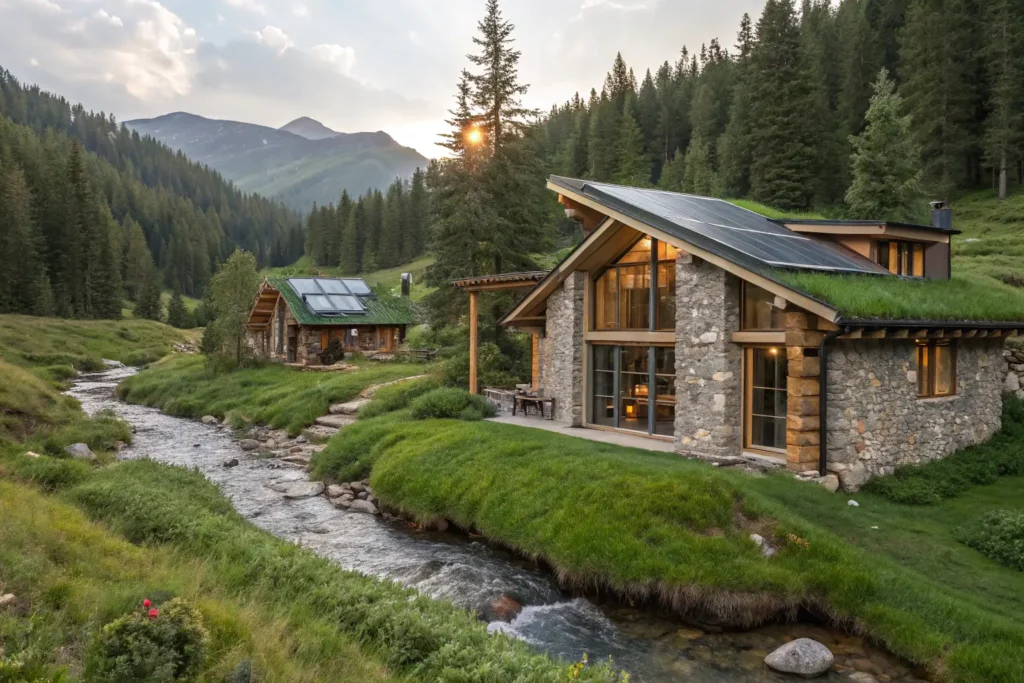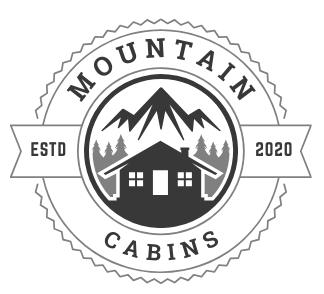Sustainable Mountain Cabins: Eco-Friendly Design Tips for Nature Lovers
Designing a sustainable mountain cabins allows you to enjoy the serenity of nature while minimizing your environmental footprint. By incorporating eco-friendly building practices, you can create a stylish and functional retreat that harmonizes with its surroundings. Below are practical tips and ideas for designing a sustainable mountain cabin.

1. Harness Solar Energy for Power
- Why Solar Works in Mountain Cabins:
Mountain locations often have ample sunlight, making solar panels an efficient way to generate clean energy. - How to Incorporate Solar Power:
- Install photovoltaic (PV) panels on your roof or in a sunny clearing.
- Use solar-powered lights and water heaters to reduce dependency on traditional energy sources.
- Benefits:
Lower energy costs, reduced carbon footprint, and long-term sustainability.
2. Use Reclaimed and Locally Sourced Materials
- Why It’s Sustainable:
Reclaimed materials like wood, metal, and stone reduce the demand for new resources while adding character to your cabin. - Practical Applications:
- Build furniture and accents using salvaged wood from barns or demolition sites.
- Use local stone for fireplaces and foundations to lower transportation emissions.
- Aesthetic Advantage:
Creates a rustic yet modern look, enhancing the cabin’s connection to nature.
3. Optimize Water Usage with Rainwater Harvesting
- Why It’s Eco-Friendly:
Rainwater harvesting reduces strain on local water supplies, particularly in remote areas. - How to Set It Up:
- Install gutters and downspouts to channel rainwater into storage tanks.
- Use filters to purify the water for irrigation or non-potable use.
- Added Bonus:
Helps maintain a self-sufficient water supply, even during dry seasons.
4. Insulate for Energy Efficiency
- Why Insulation Matters:
Proper insulation reduces energy usage for heating and cooling, crucial in fluctuating mountain climates. - Eco-Friendly Insulation Options:
- Wool or cotton insulation for natural temperature control.
- Recycled cellulose or spray foam for better heat retention.
- Benefits:
Keeps your cabin cozy in winter and cool in summer, saving energy.
5. Incorporate Passive Design Elements
- What Is Passive Design?
A design approach that maximizes natural heating, cooling, and lighting. - How to Apply It:
- Orient the cabin to take advantage of sunlight for warmth in winter.
- Use large windows to bring in natural light while framing stunning views.
- Install overhangs or shades to block harsh summer sun.
- Impact:
Reduces reliance on artificial lighting and climate control systems.
6. Invest in Eco-Friendly Heating and Cooling
- Alternative Heating Options:
- Install a wood-burning stove or pellet stove for renewable heat.
- Consider geothermal systems for sustainable temperature regulation.
- Cooling Solutions:
- Use cross-ventilation and ceiling fans instead of air conditioning.
- Plant native trees around the cabin to provide shade and regulate temperature.
7. Choose Non-Toxic and Sustainable Finishes
- Why Materials Matter:
Some paints, stains, and finishes release harmful chemicals into the environment. - Eco-Friendly Alternatives:
- Use low-VOC (volatile organic compound) paints and stains.
- Seal wooden surfaces with plant-based oils or beeswax for a natural finish.
- Result:
A healthier indoor environment with reduced environmental impact.
8. Design Compact, Multi-Functional Spaces
- Why Smaller Is Better:
A smaller cabin uses fewer materials, requires less energy, and leaves a smaller environmental footprint. - Smart Design Ideas:
- Build multi-functional furniture like storage beds and folding tables.
- Incorporate open layouts to maximize usable space without expanding the footprint.
9. Blend the Cabin with Its Surroundings
- Why Integration Matters:
A cabin that harmonizes with its environment minimizes visual and ecological disruption. - Design Suggestions:
- Use earth-tone exteriors that match the landscape.
- Preserve existing vegetation and build around natural features like rocks and trees.
- Added Benefit:
Maintains the natural beauty of the location while reducing landscaping needs.
10. Use Eco-Friendly Lighting and Appliances
- Lighting Tips:
- Use LED bulbs for energy-efficient illumination.
- Install solar-powered outdoor lights for pathways and decks.
- Appliance Selection:
- Choose Energy Star-rated refrigerators, ovens, and washing machines.
- Opt for compact appliances to suit the cabin’s size and energy needs.
The Big Picture: Creating a Sustainable Mountain Cabin
Building a sustainable mountain cabin doesn’t mean sacrificing style or comfort. By prioritizing green practices like solar energy, reclaimed materials, and water conservation, you create a home that respects nature while providing a cozy retreat. Whether you’re building from scratch or renovating an existing structure, these eco-friendly tips will help you design a cabin that reflects your love for the environment.

